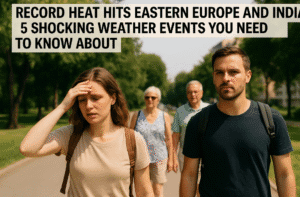Record Heat Hits Eastern Europe and India: 5 Shocking Weather Events You Need to Know About
Eastern Europe and western Russia reeled from record-breaking heat last week, with Poland’s Łeba hitting 29.6°C (20°C above average) and Lithuania shattering a 66-year April high. The surge, fueled by a high-pressure “heat dome,” now faces a dramatic reversal as Arctic air threatens weekend temperatures 5–10°C below normal, risking crops and energy demands. Meanwhile, India’s fleeting thunderstorm relief fades, with northwest regions bracing for 45°C heatwaves—5–10°C above seasonal norms—amplifying health risks in crowded cities. Reduced pre-monsoon storms have allowed heat to build unchecked, highlighting vulnerabilities in regions where labor and infrastructure clash with extreme weather.
While single events can’t be solely pinned to climate change, the pattern aligns with global trends of earlier, intensified heat seasons. From Moscow’s looming cold snap to Delhi’s deadly humidity, these extremes underscore the urgent need for adaptive strategies—cooling shelters, heat-resistant crops, and equitable policies—to protect communities in an era of growing meteorological volatility.

Record Heat Hits Eastern Europe and India: 5 Shocking Weather Events You Need to Know About
Eastern Europe and western Russia are experiencing a meteorological rollercoaster this spring, swinging from unprecedented warmth to an anticipated sharp cold snap—a stark reminder of nature’s unpredictability. Meanwhile, India’s battle with extreme heat resurges, underscoring the mounting challenges of climate resilience. Here’s a deeper dive into these phenomena and their human implications.
Europe’s Spring Furnace: When April Feels Like June
Last week, Eastern Europe and western Russia shattered temperature records, with regions experiencing heat more typical of early summer. In Poland, the coastal town of Łeba hit 29.6°C (85.3°F)—a staggering 20°C above its April average. Lithuania’s mercury soared past 29°C, obliterating a 66-year-old record, while Latvia and Estonia also logged new national highs.
The Culprit: A dominant high-pressure system over Russia acted like a lid, trapping warm air and allowing relentless sunshine to bake the region. Such “blocking highs” are known to disrupt typical weather patterns, often leading to prolonged extremes. While pleasant for sun-seekers, these temperatures strain infrastructure unprepared for early heat, from overwhelmed power grids to agriculture facing premature crop blooms vulnerable to subsequent frosts.
A Cold Twist Ahead: By weekend, a high-pressure shift over northwest Europe will funnel Arctic air southward. Moscow, now basking in temperatures 10–15°C above average, could see daytime highs plummet to single digits—5–10°C below normal. This whiplash poses risks: tender vegetation may freeze, and residents scrambling to adjust heating systems face energy spikes.
India’s Heatwave Resurgence: Relief Fades, Risks Return
After brief thunderstorms offered respite, northwest and central India brace for temperatures nearing 45°C (113°F)—5–10°C above seasonal norms. States like Rajasthan and Gujarat are under heatwave alerts, with dry winds replacing transient rains.
The Pre-Monsoon Paradox: April and May are typically India’s hottest months, but thunderstorms (known as “Nor’westers”) usually temper the heat. This year, reduced storm activity has allowed heat to build relentlessly. Urban centers like Delhi, where concrete amplifies temperatures, face heightened health risks, particularly for outdoor laborers and marginalized communities lacking cooling resources.
Human Toll and Adaptation: Authorities urge hydration and avoiding midday sun, but systemic challenges persist. A 2022 study linked extreme heat to a 55% rise in mortality risk in South Asia over two decades. Innovations like Ahmedabad’s Heat Action Plan—which includes cooling centers and public awareness campaigns—highlight proactive measures, yet rural areas remain vulnerable.
Broader Implications: Climate Variability or a New Normal?
While linking single events to climate change requires caution, rising global temperatures are increasing the frequency and intensity of heat extremes. Europe’s April spike aligns with trends showing earlier springs and prolonged heat episodes. Similarly, India’s lengthening heatwave seasons—now starting as early as March—reflect broader shifts.
Preparedness as Priority: These events underscore the need for adaptive infrastructure, from heat-resistant crops to urban green spaces. In Europe, cities like Paris are investing in “cool roofs,” while Indian states are experimenting with reflective pavements. Policymakers face dual mandates: mitigating long-term warming and safeguarding populations today.
Final Outlook: Vigilance in the Face of Extremes
As Eastern Europe navigates temperature whiplash and India endures its furnace-like pre-monsoon phase, these events serve as a call to action. Individual adaptability—like adjusting work hours to avoid peak heat—matters, but systemic solutions are critical. In a world where weather records are increasingly obsolete, resilience hinges on innovation, equity, and global cooperation.
For now, residents from Warsaw to Mumbai are reminded: in the age of climate uncertainty, expecting the unexpected is the new norm.
You must be logged in to post a comment.